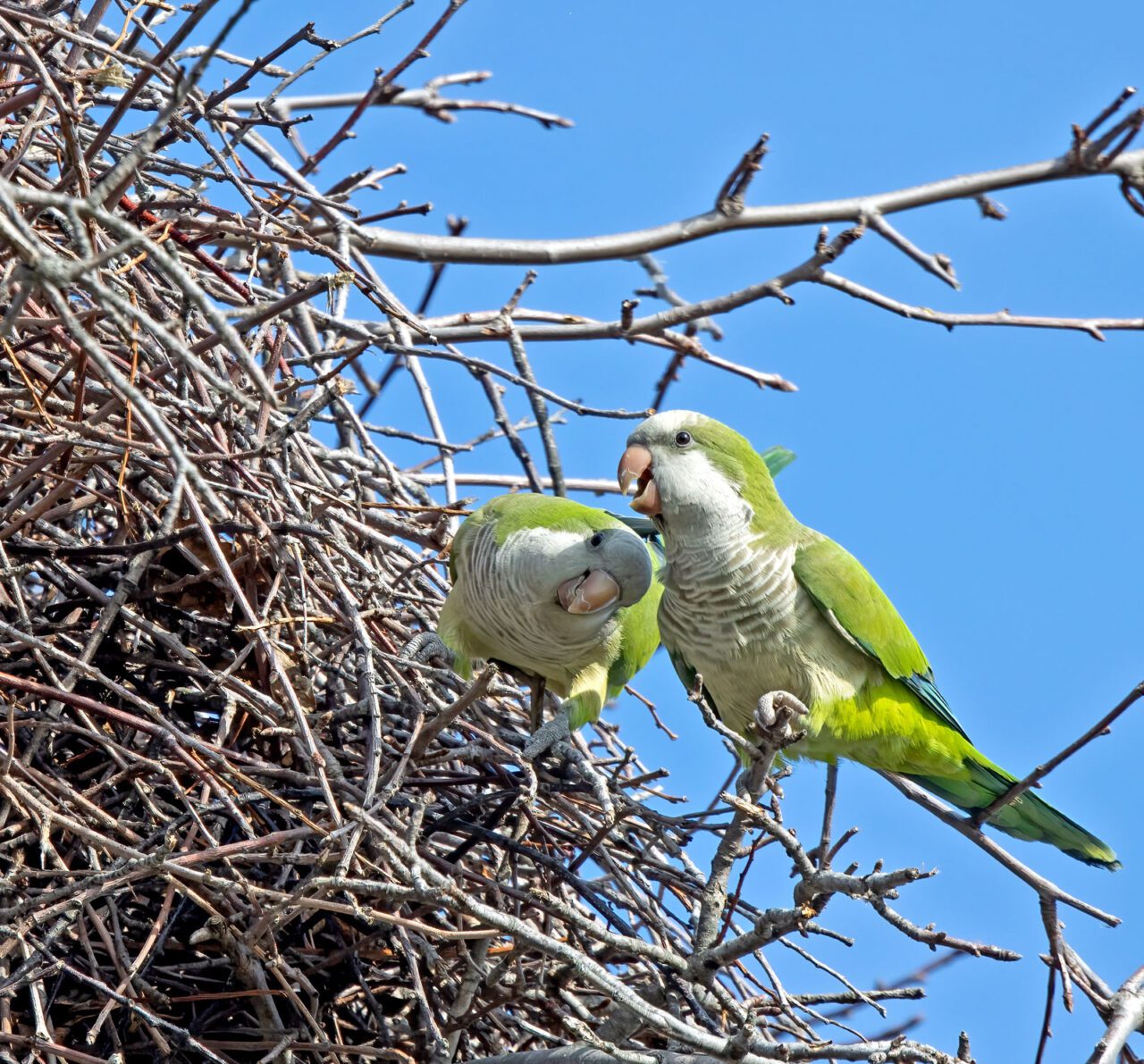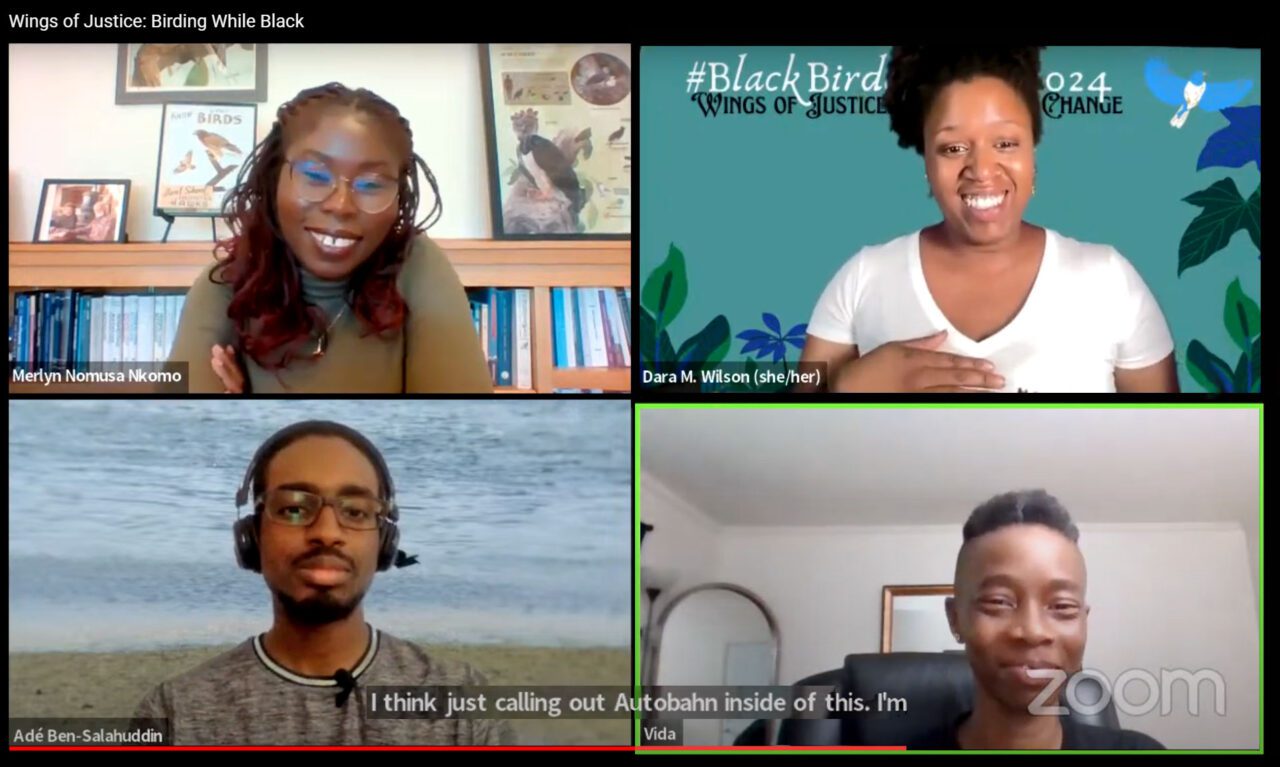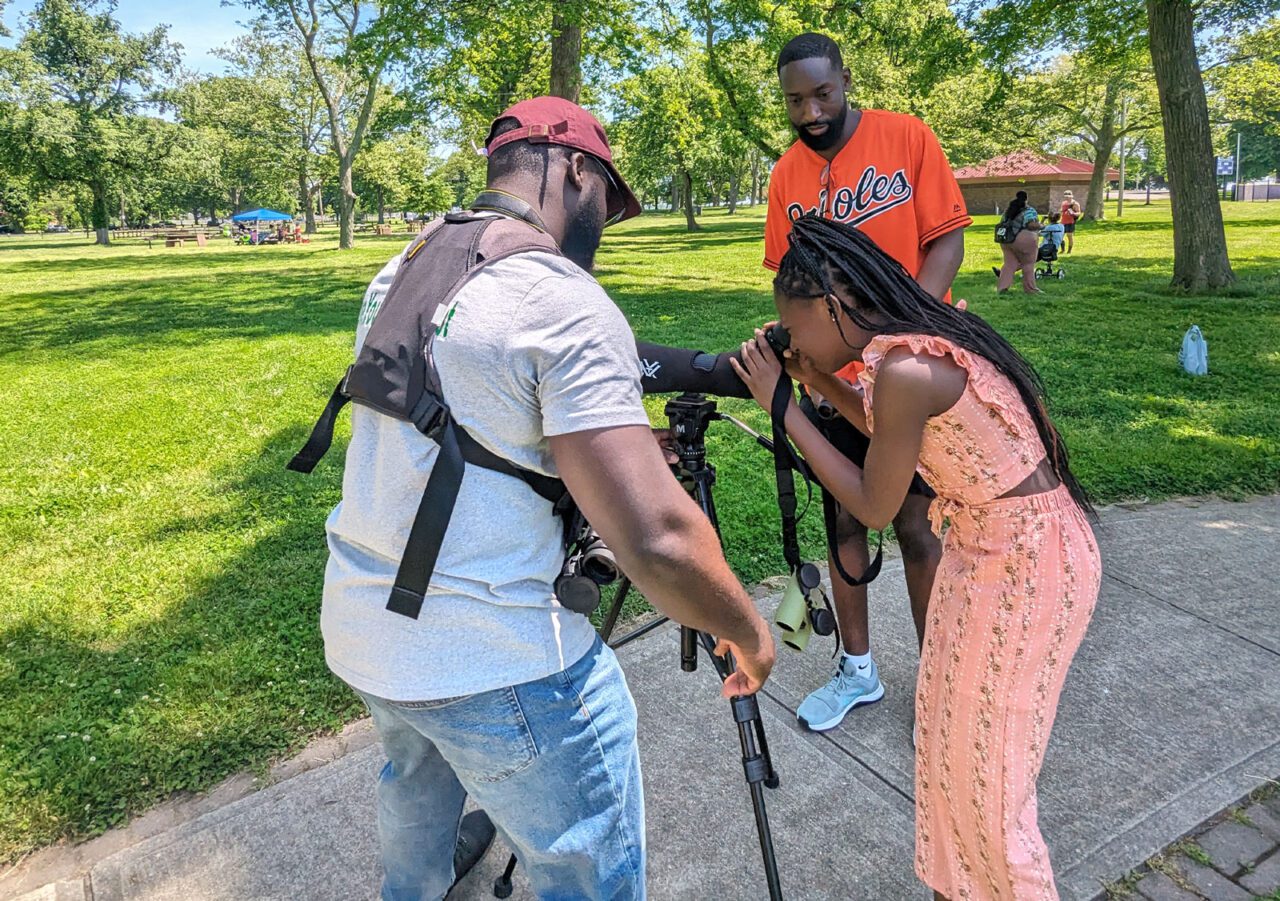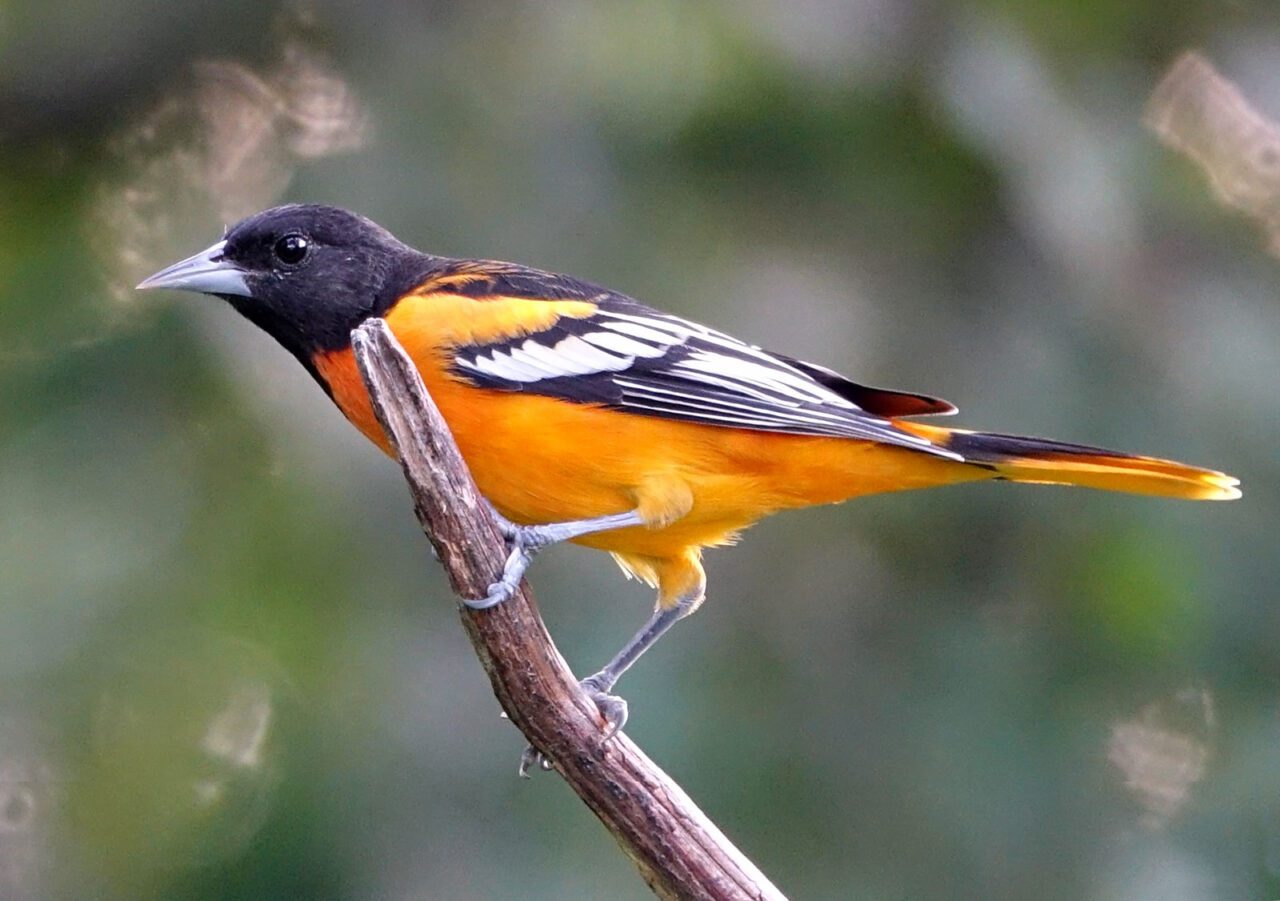
A gentle northward breeze blew off Long Island Sound, cooling the morning air in the amphitheater of Seaside Park in Bridgeport, Connecticut. Out beyond the pond, people started to filter in past foraging starlings and grackles. As they entered the park, they walked under the massive communal nests of our local Monk Parakeets. There was a noisy spat going on between two of the bright-green birds, and laughter broke out as some folks started discussing the nature of the dispute as if it were a plot point in an Oprah Winfrey Network family drama.
My anticipation rose. I had recently attended local bird walks with groups of mostly white birdwatchers. But today, as a trip leader on my home turf in Connecticut, I was excited to stand in front of a nearly all-Black crowd and say:
“Welcome to the first official event of Black Birders Week 2024!”
Now in its fifth year, Black Birders Week 2024 featured over two dozen online and in-person events from May 26 to June 1, to celebrate, encourage, and highlight the work and presence of Black people in birding, ornithology, and conservation. It was born in 2020, in response to a series of racially traumatic encounters involving Black people in the outdoors, including but sadly not limited to Christian Cooper’s Central Park incident. Out of the turmoil of 2020, which laid bare so many social, environmental, and health disparities, the organizers of Black Birders Week created an annual tradition that showcases all the shades of our experiences in the outdoors.
For the last three years I have been an organizer of Black Birders Week, and this year’s theme, “Wings of Justice: Soaring for Change”, resonated with me as a chance to pause and take in the longevity and successes of this grassroots movement. But it was also a moment to reflect and ask: what has actually changed in the world of birding and ornithology?




Acceptance Is Spreading, But Progress Is Slow
To start, it’s been encouraging to see Black Birders Week—and even simply the existence of Black birders—gain recognition and in many cases warm acceptance by majority-white birding organizations on social media. The National Audubon Society, Cornell Lab of Ornithology, BirdNote, Wild Birds Unlimited, and other groups have helped host events and offered assistance. More broadly, it feels like many white birdwatchers have become aware that there are Black birders out there who are motivated by much the same sense of fun, curiosity, and wonder about our avian cousins.
More About Black Birders Week
This growing acceptance is palpable on social media. Nowadays, when #BlackBirdersWeek has been posted, I’ve seen fewer sarcastic comments like “I’m confused, is this a week celebrating black birds?” or the tired “When is White Birders Week?” as more and more white people see the value of events like ours (and even step up to respond to online detractors).
But at the same time, it feels like the depth of the issues that many Black birders care about has yet to be fully grasped. It’s a positive sign that dozens of organizations from across the country and the world are now reaching out to connect with Black Birders Week. But it’s also exhausting that much of this interest happens at the eleventh hour, in ways that make it clear that they’re still not familiar with their own local Black birders and communities. There’s only so many times my co-organizers and I can field inquiries about whether we know anybody in a state none of us are from.
Black Birders Week explicitly welcomes people of all ethnicities and backgrounds. But our main goal is to curate a space where Black experiences in nature are the focal point. In that respect, Black Birders Week is not just hosting a walk led by a Black birder to an audience of largely white people, and it can be hard to consider it a Black Birders Week event if literally no one involved is Black. We want these events to be opportunities for Black birders of all levels to share their experiences in community with each other, without being filtered through the lens of white culture (an idea that Nobel laureate Toni Morrison has called operating “beyond the white gaze”). At a Black birding event held in South Carolina, as American Goldfinches twittered overhead, one attendee likened their calls to a group of AKA sorority sisters. It’s only at events like ours that this kind of cultural reference would come up and be understood.


Birdwatching Is About People, Too
“People need to realize that it’s not just about birds,” says Nicole Jackson, an environmental educator from Ohio and a founding Black Birders Week organizer. “Expecting the Black community to focus on conservation without addressing how our immediate and historical struggles make it difficult to engage fully in environmental efforts highlights a significant issue—especially now that it’s another election year with all of its similar controversies.”
With this in mind, we focused the bulk of this year’s online conversations on the human side of birding. Panelists explored how Black people have used birds and nature to aid in mental health and mourning journeys, including a moving keynote from D.C.-based falconer Rodney Stotts, and a beautiful reflection on loss and grief from Christy Hyman, a historical geographer. Additionally, we prominently featured members of the corvid family, highlighting both their boisterous intelligence and their use in anti-Black racist symbology. Lawyer and filmmaker Alice Crowe shared the history of her surname in the context of the Jim Crow laws that for a century relegated her family to second-class citizenship.


Even in recent years, some of the major bird conservation institutions have made missteps when it comes to equitably engaging with Black communities and scientists. Shortly after the first Black Birders Week, the National Audubon Society publicly acknowledged that their namesake, John James Audubon, was an enslaver who, in their words, had “ethical failings” and whose science “has sometimes been called into question.” Yet it seemed to me that the society’s concern about those ethical failings was ultimately trumped by brand recognition in last year’s announcement of their decision to retain the Audubon name—even though that association carries little weight outside of the conservation mainstream.
“Most folks… when they hear that name for the first time, they think I’m talking about a highway in Germany,” said Tykee James, president of the DC Bird Alliance (formerly the DC Audubon Society) in the DCist last year. “They’re not thinking about bird conservation.”
While many among Audubon’s current membership may revere the man, the decision still stings for the rest of us. “The biggest thing for any organization to take away from this is listening to what is important and what holds weight for the very community that you wish to engage with,” said tech blogger Corvida Raven during a panel discussion hosted by National Audubon. “There’s always conversations about inclusion and diversity, but when someone calls you out on something as inconsequential as a name change? If we can’t make it there, what could we actually even hope for at this point?”(Watch Corvida Raven’s full comment.)


To Succeed, Conservation Needs Everyone
When organizations fail to equitably engage with Black communities and scientists, the results can be directly detrimental to conservation efforts amid the ongoing biodiversity crisis.
In 2023, towards the end of last year’s Black Birders Week, the Cornell Lab of Ornithology itself provided an unintended example. With the Lab’s help, The New York Times launched a well-intentioned but poorly aimed participatory science project that encouraged people to go birding during the summer and collect data in places with low birder coverage. The project highlighted an important issue, but the planning and rollout didn’t include scientific experts on the contribution of social factors to data gaps, such as Deja Perkins, a PhD student of geospatial analytics at North Carolina State University and a founder of Black Birders Week.




As Perkins told BirdNote, gaps in participatory science projects like eBird and iNaturalist are directly correlated to the racial and socioeconomic demographics of their participants. Older affluent white people tend to go birding in their own neighborhoods or large parks. “People aren’t submitting [as many] observations in areas that have a higher BIPOC population or are lower income,” Perkins told me. “I don’t think the way [the NYT] framed their article was accurate to the research, nor to the importance of diversity in birding.”
From my perspective as a Black birder and someone interested in science outreach, it was a frustratingly baffling move for the Times to tackle the issue of data gaps with a paywalled readership that is only around 4% Black and 10% Hispanic, while offering little information on ways to bring birding to new audiences. “I thought it was very harmful and inauthentic,” Perkins continued, “and just goes to show the importance of Black Birders Week and the unique way that we tailor our topics to talk about the connections between the natural world and the human world.”
BirdNote has tapped into these connections and helped make inroads with Black audiences by adding a more human angle to their programming. Their Bring Birds Back podcast, now in its sixth season, often features Black experts and hosts (including yours truly) and focuses on the overlap between social and environmental justice. For this year’s Black Birders Week, they hosted a session on the heat island effect, exploring how urban birds and birders cope during increasingly hot summers.
To foster connections among birders, we need to go beyond just the connections to birds themselves—and paying attention to culture is a key part of that. On the aforementioned Audubon panel, Zimbabwean raptor researcher Merlyn Nomsa Nkomo described how she’s moving beyond the Eurocentric cultural norms around birding. She incorporates local languages like Shona into her outings. She adopts familiar cultural practices, too, including ending each birdwalk with a braai, the southern African version of a cookout. “We’re creating a culture of our own around what birding entails, that makes people feel safe,” she said.
And when people feel safe and in community, that’s when the fun is had. That’s what’s kept us coming back to Black Birders Week for five years, even when it seems like so much is moving too slow or in the wrong direction.




Towards the end of our bird walk at Seaside Park, a Black man in a Baltimore Orioles jersey and his young sister walked up and asked what we were doing. Turns out, we’d just spotted an actual Baltimore Oriole, and we helped them get a look at it through our spotting scope. The man marveled at the bird’s brilliant orange-and-black for a while, then stuck around for an extra hour in the midday May heat as the group chatted about local legislative policy for improving community health with native plants. Before he finally left, he expressed how happy he was to have a new hobby to share with his sister and was looking forward to the next group outing.
For now, it’s only at events like ours that a serendipitously timed brotha might feel comfortable approaching a group of 25 birdwatchers to check out what they’re doing, let alone join in. But that’s where I hope we’re headed. To get there, we’ll need the contemporary birding world to broaden out beyond the dominant white culture it emerged from.
I don’t know about you, but I think we need more events like ours. Because true diversity in science ain’t just for the birds.
About the Author
Adé Ben-Salahuddin has been a co-organizer of Black Birders Week since 2022. He credits the group and its movement for both his interest in birding and for reinvigorating his pursuit of a career driven by his own passions as he works toward B.S. (’25) and M.S. (’26) degrees in Biology. You can follow him on X and YouTube for videos about evolution, prehistoric life, the people who study it, and how we talk about it. Accordingly, his favorite birds are all extinct (terror birds and enantiornithines).

